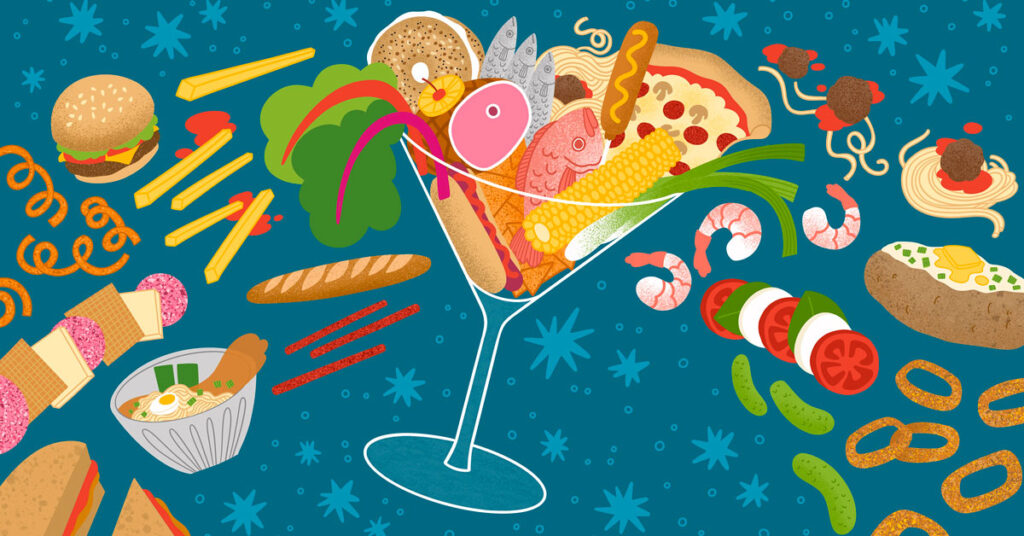At one time, sipping a Bloody Mary was the closest you could get to making a cocktail feel like a meal, but ever since PDT infused its Old Fashioned with bacon-washed bourbon in 2007, cocktails have taken their cues from the dinner plate. While Benton’s Old Fashioned still looks like an Old Fashioned, today’s food-inspired cocktails reverse the food-flavoring technique by adding it to a liquid form. So instead of adding bacon flavor to a cocktail, you make a cocktail that tastes just like bacon. These food-inspired cocktails are everywhere, and they’re a little weird.
At Singe’s in Manhattan, they’ve come up with a new hand-rolled cocktail that uses wasabi, seaweed, and bonito flakes to replicate the flavors of sushi; Nashville’s Four Walls is doing something similar with their Emerald City, using wasabi, Calpis, and sesame oil; and at Leyenda in Brooklyn, their Daiquiri al Pastor uses pork fat-washed rum, achiote, and pineapple to recreate the popular Mexican meat dish; at Danico in Paris, their Zaru Soba adds cucumber and tomato with soy sauce and soy milk to evoke a noodle soup, while Brooklyn’s Lilister serves up a cocktail inspired by hot dogs (and fried pickles and ranch dressing). Tokyo Confidential in Tokyo also has a hot dog-inspired drink, made with gin, shochu, onion brine, MSG and sous-vide sausage, poured tableside from a ketchup bottle and into a glass lined with red and yellow cocoa butter to mimic ketchup and mustard.With this in mind, it’s no surprise that the Chicken Soup Martini and Melon and Prosciutto Sour have become trending on TikTok.
This trend may be due to the success of Manhattan bar Double Chicken Please, whose entire menu is modeled after familiar dishes like the Waldorf salad and cold pizza. Novelty aside, the shock that the cocktails are actually good has helped the bar gain popularity and land it on the World’s 50 Best list. In fact, many of the menus on the World’s 50 Best Bars feature food-inspired cocktails, such as the Caprese at Martiny’s and the Roasted Corn Sour at Superbueno.
In the hands of a skilled bartender, these trends can be transcendent. But there comes a turning point in every trend, when the creativity and innovation that started it all solidifies into a formula that’s the opposite of creativity. And it seems many bars have learned their lesson: a cocktail that mimics food equals success. From porcini risotto to tarte tatin, there’s a new food-flavored cocktail everywhere you look, but their appeal lies more in their daring than in the drink’s exact makeup. Sure, you can have a cocktail that tastes exactly like a hot dog. But would you want to drink it?
According to Tom Liu, head bartender at Thunderbolt in Los Angeles, one reason for this trend has to do with tapping into customer nostalgia. People don’t grow up drinking, they grow up eating. “We have customers who may not know what a Negroni tastes like, but they know the food they had as a kid,” he says. Ingredients and cocktails that tout flavors like cacio e pepe are appealing, especially to people who are more comfortable drinking beer. At Thunderbolt, which has a “food-inspired” section on its cocktail menu, some drinks also incorporate ingredients from the dinner menu to reduce overall waste. For example, the Bloody Mary is made with pot liquor left over from cooking the restaurant’s collard greens.
For Liu, a good food-inspired cocktail should bring out the core elements of the vegetable or spice and actually evoke the dish. Perhaps that’s why there are so many flops out there. “I’ve had the same experience: an ingredient looks really interesting, so I go to try it, but in the end, I can barely taste the ingredient. It’s like a clickbait situation,” Liu says. The menu advertises some kind of transformative experience, only to be severely disappointed.
The term “clickbait” also fits the proliferation of these kinds of cocktails on TikTok, where content creators may promise their creations are delicious and reproducible, but viewers don’t even have to taste what’s being made. Again, this serves as a hook: “How weird! Who would do something like that?” You can indulge in the eternal Willy Wonka fantasy of drinking a daiquiri that tastes exactly like a Caesar salad or miso soup, without ever being reminded that these cocktails will probably be more weird than fun.
The premise of serving food-inspired drinks in a bar atmosphere comes with its own pitfalls — after all, just because you love al pastor tacos doesn’t mean you necessarily want a drink that tastes like it — and the best versions of these cocktails must balance novelty with drinkability.
Done well, a cocktail like this is truly a feat. But mimicking cuisine isn’t the only way to show off your craft. For bars to jump on this trend only flattens the creative landscape. Cocktails that taste like something you’ve had before are fun. Leave room for cocktails that taste like something you’ve never imagined.


